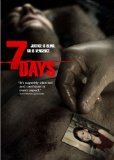Bruno Hamel (Claude Legault), a surgeon, and his wife Sylvie (Fanny Mallette) enjoy an afternoon tryst while their young daughter Jasmine (Rose-Marie Coallier) heads off to school. Tragedy strikes, though, when Jasmine is assaulted and killed by pedophile Anthony Lemaire (Martin Dubreuil). Bruno and Sylvie are devastated, and each deals with the tragedy an unhealthy way, with Sylvie withdrawing from the world and her husband, and Bruno plotting vengeance. Lemaire is caught, but doesn’t remain in police custody long, since Bruno kidnaps him and carries him off to a secluded cottage in the forest. His plan: torture Lemaire for the seven days leading up to what would have been Jasmine’s birthday, and then kill him. The police investigation becomes at least as much about saving Bruno’s soul as it is about saving Lemaire’s life.
Rightly or wrongly, so-called “torture porn” is one of the more reviled subgenres of horror film. While there is no denying that the worst films of this type can be among the most mind-numbing and depressing bits of celluloid stupidity, aesthetically as well as ethically bankrupt, it is just as true that the best can force the viewer into some extremely uncomfortable, but artistically and philosophically vital, territories. One should also bear in mind that though the term “torture porn” is new, that type of story has been around forever. No less a figure of classic horror than Bram Stoker himself wrote a short story called “The Squaw,” wherein a character experiences a sexual thrill by installing himself in an iron maiden (until, of course, things go rather wrong). And if we go all the way back to the birth of literary horror, with the arrival of the Gothic novel at the end of the 18th century, the Marquis de Sade was right there at the start, penning works that articulated what the English Gothics only hinted at, and that depicted horrors that go far beyond anything Eli Roth has dared put on the screen.
Perhaps it is a coincidence, but it is interesting to note that many of the strongest recent works of extreme horror have been French (in language, if not always in nationality): Calvaire, Inside, Martyrs, Frontier(s). These are works that are squarely in the tradition of extreme French horror that runs from Sade to Octave Mirbeau (the author of Torture Garden) to such important films as Eyes Without a Face (1960). All of which brings me to Seven Days (Les Sept Jours du Talion), Quebec’s entry into the revenge/torture sweepstakes.
Director Podz knows when to show restraint, and when to cut loose. Mercifully, Jasmine’s awful fate is kept off-screen and is taken care of within the first ten minutes of the film, allowing the viewer to concentrate on the dark journey undertaken by Bruno. The nastiness he inflicts on Lemaire is creative and graphic. Of course, this is a case where the victim of the torture is so despicable that it is hard to feel sorry for him, but should we be cheering Bruno on? If we are, what does that say about us? This is a film that eliminates any trace of the easy answer, just as it assaults the viewer with brutally hard questions. Believe me: you will be arguing after the credits roll, even if only with yourself. If you thought the spinning top at the end of Inception set off discussion, just wait until the final, brilliantly understated final lines of dialogue here.
A superb piece of work, then, and one where every drop of blood, every blow of a hammer, is not only justified, but necessary.
Video
The film is about the outer limits of human emotion, but the look, by contrast, is positively chilly, and an integral part of the collision between restraint and extremity that lies at the thematic heart of the work. The palette is stark, dominated by cool grays and whites, and the camera movement is both slow yet constant, restless. All of this is beautifully handled by the transfer, which gives us excellent sharpness, flesh tones and contrasts. There is a bit of grain, however, and the occasional touch of visible edge enhancement. The aspect ratio is the original 2.35:1 anamorphic widescreen, or at least the Canadian edition is. I notice that Amazon lists the American edition as being a 1.77:1 ratio, which may be a mistake, but consider it flagged.
Audio
Even more chilly restraint here. So much of the film is about silence, much of it of a horrible, emotionally damaging nature. There is no score, and Bruno never speaks to Lemaire. There still is plenty of dialogue, however, and it never distorts. The sound design is spare, but makes excellent use of 5.1 placement. Excellent work.
Special Features
Deleted Scenes: (5:35) Four of them.
Photo Gallery: (6:25) In slide-show form.
Trailers.
Final Thoughts
While this may not find favour with the Saw crowd, it is ten times more interesting and vital than that series, and a hundred times less verbose.






